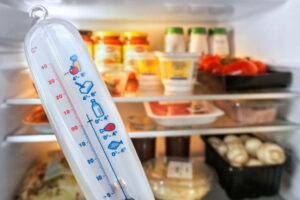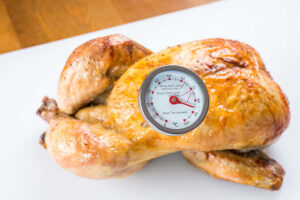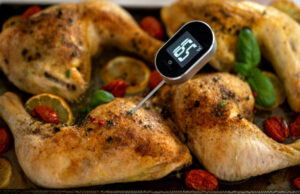Using a Food Thermometer
go.ncsu.edu/readext?1023043
en Español / em Português
El inglés es el idioma de control de esta página. En la medida en que haya algún conflicto entre la traducción al inglés y la traducción, el inglés prevalece.
Al hacer clic en el enlace de traducción se activa un servicio de traducción gratuito para convertir la página al español. Al igual que con cualquier traducción por Internet, la conversión no es sensible al contexto y puede que no traduzca el texto en su significado original. NC State Extension no garantiza la exactitud del texto traducido. Por favor, tenga en cuenta que algunas aplicaciones y/o servicios pueden no funcionar como se espera cuando se traducen.
Português
Inglês é o idioma de controle desta página. Na medida que haja algum conflito entre o texto original em Inglês e a tradução, o Inglês prevalece.
Ao clicar no link de tradução, um serviço gratuito de tradução será ativado para converter a página para o Português. Como em qualquer tradução pela internet, a conversão não é sensivel ao contexto e pode não ocorrer a tradução para o significado orginal. O serviço de Extensão da Carolina do Norte (NC State Extension) não garante a exatidão do texto traduzido. Por favor, observe que algumas funções ou serviços podem não funcionar como esperado após a tradução.
English
English is the controlling language of this page. To the extent there is any conflict between the English text and the translation, English controls.
Clicking on the translation link activates a free translation service to convert the page to Spanish. As with any Internet translation, the conversion is not context-sensitive and may not translate the text to its original meaning. NC State Extension does not guarantee the accuracy of the translated text. Please note that some applications and/or services may not function as expected when translated.
Collapse ▲If you read this column often, you know that I frequently recommend (I didn’t say preach about) the need for a food thermometer to ensure the safety of your food.  Using a thermometer to check food in the refrigerator as well as a final cooking temperature is a good way to reduce both food-related illnesses and food waste. The food thermometer is an essential tool for restaurants and other food service employees. But, are they used by home cooks? Sadly, not so much.
Using a thermometer to check food in the refrigerator as well as a final cooking temperature is a good way to reduce both food-related illnesses and food waste. The food thermometer is an essential tool for restaurants and other food service employees. But, are they used by home cooks? Sadly, not so much.
In 2019 the United States Department of Agriculture Economic Research Service (USDA-ERS) researched this topic. They found that 67% of those studied have a food thermometer in their kitchen, but only 14% use them.
Many people cook meats to “temperatures” such as rare, medium or well-done because that’s how they like to eat their meat. Some do this looking at the color of the meat itself or its juices. Others (including famous TV chefs) say they can tell the doneness by the texture of the meat when they touch it. None of these are indicators of the actual temperature or safety of the meat. When using a thermometer, we know the food has reached the temperature needed to kill specific microorganisms that could cause illnesses. Using a thermometer takes the guesswork out of deciding if food is safe.
Not only can food thermometers be used to determine the temperature of cooked
foods, they can also be used to measure the temperature of food a refrigerator or
freezer. They’re good tools to have all the time, but they could be essential to help
evaluate the safety of cold foods during or after a power outage.
There are several types of thermometers available, the two basics are:
- Dial oven-safe thermometers can remain in place as the food cooks. This type of thermometer is good for large items such as turkeys, roasts and casseroles. The stem of these thermometers needs to be inserted into the food about 2 ½
inches. It may take several minutes for the actual temperature to be determined. - Instant-read thermometers can be either dial or digital. They aren’t meant to be left in the food while cooking. They are used check temperatures toward the end of cooking or in the refrigerator. Instant read thermometers can be used for all foods including thin pieces. Digital thermometers instant-read thermometers can give fast readings in two to ten seconds. These are the type currently recommended for food service.
Thermometers will only give an accurate reading if placed in the proper location in the food.  In general, the food thermometer should be placed in the thickest part of the food, away from bone, fat, or gristle. It’s important to find the center or the deepest part of the food you’re testing. It’s always good to get readings in two different locations depending on the size and shape of the food being cooked.
In general, the food thermometer should be placed in the thickest part of the food, away from bone, fat, or gristle. It’s important to find the center or the deepest part of the food you’re testing. It’s always good to get readings in two different locations depending on the size and shape of the food being cooked.
When using dial food thermometers, be sure the temperature sensing area of the stem is correctly inserted in the food. The stem must be inserted in the food up to the dimple or notch for an accurate reading (this could be 1-2 inches).
Some digital instant read thermometers can get an accurate temperature from just the “tip” of the stem.  This is great for thinner foods such as steaks, pork chops, burgers, boneless chicken breasts and fish. When testing these foods, it’s best to insert the thermometer horizontally, into the side of the meat, making sure to push the probe in far enough to reach the center.
This is great for thinner foods such as steaks, pork chops, burgers, boneless chicken breasts and fish. When testing these foods, it’s best to insert the thermometer horizontally, into the side of the meat, making sure to push the probe in far enough to reach the center.
Having a thermometer is only the beginning. You then need to make sure you know the appropriate temperatures for each type of food. The FoodSafety.gov website provides a detailed list of safe minimum cooking temperatures for a variety of foods. The general rule-of-thumb for safe cold temperatures is to keep the food below 41 degrees F.
If you don’t have a food thermometer, perhaps you’ll think about getting one. Likewise, if you have one but don’t use it, hopefully you’ll think about pulling it out of the drawer to use more often.
References:
- Penn State Extension:
- USDA Food Safety Inspection Service:
- Kitchen Thermometers
- Maryland University Extension:
- Michigan University Extension:
- Surry County Cooperative Extension:
- EatRight.org:
Syracuse is a Family and Consumer Science team member and can be reached at N.C. Cooperative Extension, Brunswick County Center 910-253-2610 or by email at
clsyracu@ncsu.edu



